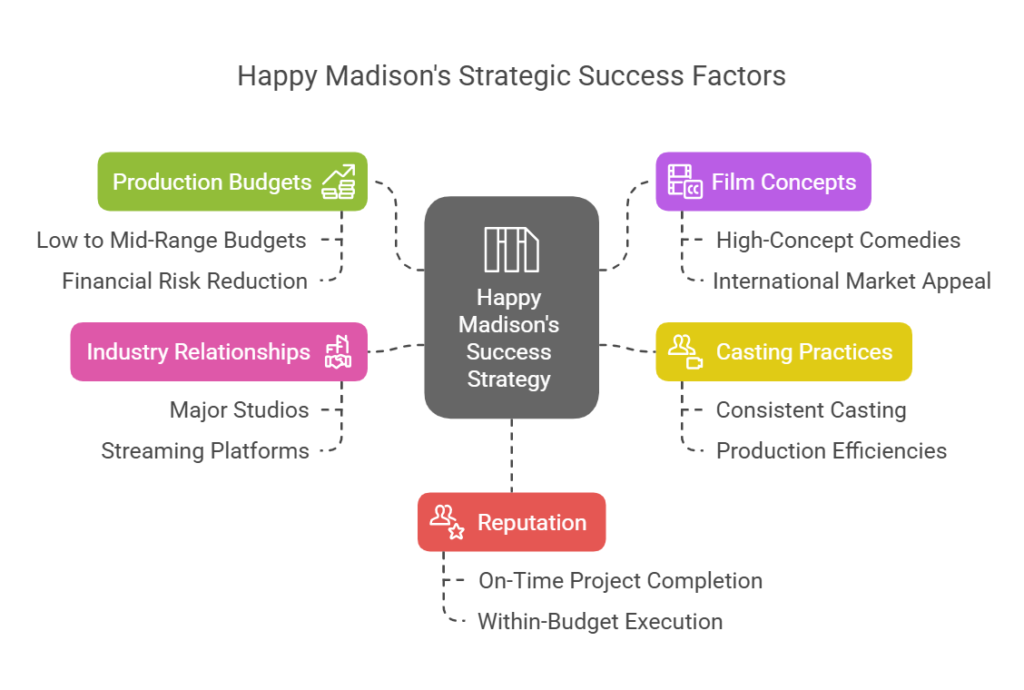Adam Sandler Net Worth (2025): How the Comedy Icon Built His $500 Million Fortune
Adam Sandler’s net worth stands at approximately $500 million as of 2025, making him one of the wealthiest actors and comedians in Hollywood.

His extraordinary financial success stems from a multi-faceted career spanning comedy, acting, producing, and groundbreaking streaming deals that have revolutionized celebrity compensation models in the entertainment industry.
How Adam Sandler’s Wealth Compares to Other Comedy Stars
| Comedian | Estimated Net Worth | Primary Income Sources |
|---|---|---|
| Adam Sandler | $500 Million | Film acting, production company, Netflix deals |
| Jerry Seinfeld | $1 Billion | TV syndication, stand-up comedy, investments |
| Kevin Hart | $480 Million | Film acting, stand-up tours, endorsements |
| Tyler Perry | $850 Million | Film production, studio ownership, TV shows |
| Ellen DeGeneres | $520 Million | TV hosting, production company, real estate |
| Tina Fey | $85 Million | Writing, acting, production deals |
| Jim Carrey | $180 Million | Film acting, art, investments |
Sandler’s remarkable wealth places him among the highest-earning comedians of all time, though still behind Jerry Seinfeld’s television syndication-driven fortune. What distinguishes Sandler from his peers is how he has leveraged his unique brand of comedy across multiple revenue streams while maintaining complete creative control over his projects.
With a clear understanding of Sandler’s financial standing, let’s explore how he built this impressive fortune from humble beginnings to becoming one of Hollywood’s most bankable stars.
Early Life and Background
Childhood and Family
Adam Sandler was born on September 9, 1966, in Brooklyn, New York, to Judith and Stanley Sandler. His father was an electrical engineer, while his mother worked as a nursery school teacher. The family moved to Manchester, New Hampshire, when Adam was six years old, providing a middle-class upbringing that gave no early indications of the wealth he would eventually accumulate.
Education and Early Influences
Sandler attended Manchester Central High School where he earned a reputation as the class clown. This natural comedic talent continued at New York University’s Tisch School of the Arts, where he graduated with a Bachelor of Fine Arts degree in 1988. During his university years, Sandler began performing stand-up comedy, laying the foundation for his future career.
First Steps Toward Comedy
Sandler’s comedy journey began in earnest with open mic nights in Boston. His breakthrough came when comedian Dennis Miller saw him perform at a Los Angeles comedy club and recommended him to Saturday Night Live producer Lorne Michaels. This pivotal connection would set Sandler on the path to financial success that few comedians achieve.
Related Post: Anil Ambani Net Worth (2025)
Career Evolution and Earnings
SNL Breakthrough and Salary
Sandler joined Saturday Night Live as a writer in 1990 before becoming a cast member from 1991 to 1995. During this period, his estimated salary ranged from $5,000 to $15,000 per episode, earning him approximately $350,000-$500,000 annually at the peak of his SNL career. While modest compared to his current wealth, this platform established his national recognition and set the stage for far more lucrative opportunities.
Comedy Albums and Tours
Between 1993 and 1999, Sandler released five comedy albums that achieved unprecedented success:
| Album | Year | Certification | Estimated Revenue |
|---|---|---|---|
| They’re All Gonna Laugh at You! | 1993 | 2× Platinum | $2.5 million |
| What the Hell Happened to Me? | 1996 | 2× Platinum | $2.4 million |
| What’s Your Name? | 1997 | Gold | $750,000 |
| Stan and Judy’s Kid | 1999 | Gold | $600,000 |
His comedy tours during this period added an estimated $5-8 million to his growing fortune, establishing multiple revenue streams beyond television and film.
Early Movie Career (1990s)
Sandler’s transition to film marked a significant financial turning point. His early movie salaries show his rapid ascent:
| Film | Year | Estimated Salary |
|---|---|---|
| Going Overboard | 1989 | $50,000 |
| Billy Madison | 1995 | $1.7 million |
| Happy Gilmore | 1996 | $2 million |
| The Wedding Singer | 1998 | $5.5 million |
| The Waterboy | 1998 | $8 million |
| Big Daddy | 1999 | $20 million |
This extraordinary salary progression demonstrates how quickly Sandler established himself as a bankable box-office star. By the end of the 1990s, he had joined Hollywood’s exclusive “$20 million club,” a remarkable achievement for a comedian.
Box Office Dominance (2000s)
The 2000s solidified Sandler’s status as one of Hollywood’s most consistent box-office performers:
| Film | Year | Box Office | Estimated Earnings |
|---|---|---|---|
| Little Nicky | 2000 | $58 million | $25 million + backend |
| Mr. Deeds | 2002 | $171 million | $25 million + profit sharing |
| Anger Management | 2003 | $195 million | $25 million + profit sharing |
| Grown Ups | 2010 | $271 million | $20 million + 20% gross |
Highest-Grossing Films
Sandler’s highest-grossing films have contributed significantly to his wealth through backend deals that allowed him to share in box office profits:

- Hotel Transylvania 3 (2018): $528 million worldwide
- Hotel Transylvania 2 (2015): $473 million worldwide
- Grown Ups (2010): $271 million worldwide
- Grown Ups 2 (2013): $247 million worldwide
- Big Daddy (1999): $234 million worldwide
Critical Reception vs. Financial Success
Interestingly, Sandler’s financial success has often run counter to critical reception. Films that were critically panned frequently became his biggest commercial hits, allowing him to develop a business model that prioritized audience appeal over critical acclaim. This strategy has proven incredibly lucrative, with his comedies consistently outperforming box office expectations despite negative reviews.
For example, “Grown Ups” earned only 10% on Rotten Tomatoes but grossed $271 million worldwide. This disconnect between critical reception and commercial success enabled Sandler to command premium salaries regardless of reviews, creating a virtually critic-proof business model that few actors have achieved.
Happy Madison Productions: Business Empire
Founding and Growth
In 1999, Sandler founded Happy Madison Productions, named after two of his hit films, “Happy Gilmore” and “Billy Madison.” This strategic business move transformed him from a highly paid actor into a powerful Hollywood producer with significant control over his projects and a much larger share of profits.
Notable Productions and Revenue
Happy Madison has produced over 50 films with varying financial performance:
| Film | Year | Budget | Box Office | Estimated Production Profit |
|---|---|---|---|---|
| Paul Blart: Mall Cop | 2009 | $26 million | $183 million | $60+ million |
| Grown Ups | 2010 | $80 million | $271 million | $80+ million |
| Just Go With It | 2011 | $80 million | $215 million | $45+ million |
| Grown Ups 2 | 2013 | $80 million | $247 million | $70+ million |
| Murder Mystery | 2019 | $72 million | Netflix Release | $70+ million (Netflix deal) |
Happy Madison’s business model typically includes production fees ranging from $5-15 million per project plus significant backend participation, generating an estimated $20-50 million annually for Sandler beyond his acting salaries.
Business Model and Success Strategy
Happy Madison’s success stems from several strategic advantages:

- Low to mid-range production budgets (typically $40-80 million) that reduce financial risk
- High-concept, broadly appealing comedies with strong international market potential
- Consistent casting of Sandler’s friends and collaborators, creating production efficiencies
- Strong relationships with major studios and streaming platforms
- Reputation for completing projects on time and within budget
These factors have made Happy Madison an unusually reliable and profitable production company, contributing significantly to Sandler’s overall wealth.
Distribution Deals
Initially partnered with Sony Pictures, Happy Madison secured favorable distribution terms that allowed Sandler to retain a higher percentage of profits than most actor-producers. In recent years, the company’s pivot to Netflix has created even more advantageous economics.
Talent Development
Happy Madison has launched or revitalized the careers of numerous comedians, creating a loyal network of collaborators while establishing Sandler as an influential Hollywood power broker. This talent development aspect has strengthened his industry position beyond pure financial metrics.
Netflix Deals: Streaming Revolution
Initial Netflix Contract Analysis
In 2014, Sandler signed a groundbreaking four-film deal with Netflix, worth an estimated $250 million ($62.5 million per film). This move was considered risky at the time but proved prescient as streaming became dominant in the entertainment industry.
Contract Extensions and Terms
| Netflix Deal | Year | Number of Films | Estimated Total Value |
|---|---|---|---|
| Initial Deal | 2014 | 4 films | $250 million |
| First Extension | 2017 | 4 additional films | $275 million |
| Second Extension | 2020 | 4 additional films | $325 million |
| Latest Extension | 2023 | 5 additional films | $400 million |
Sandler’s 2023 Netflix extension represents an unprecedented level of compensation in the streaming era, with each project averaging $80 million—significantly higher than traditional studio arrangements. The deal’s structure typically includes:
- Production budget (approximately $50-70 million per film)
- Sandler’s acting fee ($20-25 million per film)
- Production fee for Happy Madison ($5-10 million per film)
- Performance bonuses based on viewership metrics
Viewership Impact on Deal Value
Netflix has reported that Sandler’s films have generated over 2 billion viewing hours since 2014, making him one of the platform’s most valuable talent relationships. His films consistently rank among Netflix’s most-watched original content:

- “Murder Mystery” (2019): 83 million household views in first four weeks
- “Hubie Halloween” (2020): 70 million household views in first four weeks
- “Murder Mystery 2” (2023): 90 million household views in first four weeks
This extraordinary viewership has given Sandler significant leverage in contract negotiations, enabling him to secure terms that exceed traditional Hollywood compensation structures.
Also Read: Wayne Newton Net Worth
Future Streaming Partnerships
As of 2025, industry analysts project that Sandler’s next streaming deal could exceed $500 million as competition between platforms intensifies. His proven ability to drive subscriptions and engagement has positioned him as one of the streaming era’s most valuable content creators, with companies beyond Netflix potentially entering bidding wars for his future projects.
Movie Salary Breakdown
Salary Evolution (1990-Present)
Adam Sandler’s salary progression represents one of the most successful financial trajectories in Hollywood history:
| Era | Average Salary Per Film | Notable Examples |
|---|---|---|
| Early Career (1989-1994) | $50,000-$1 million | “Going Overboard,” “Airheads” |
| Breakthrough (1995-1998) | $1.7-8 million | “Billy Madison,” “The Wedding Singer” |
| A-List Status (1999-2005) | $20-25 million | “Big Daddy,” “Anger Management” |
| Peak Star Power (2006-2014) | $20-25 million + backend | “Grown Ups,” “Jack and Jill” |
| Netflix Era (2015-Present) | $25-30 million + production fees | “Murder Mystery,” “Hustle” |
This steady upward trajectory, without the salary declines many actors experience in their later careers, distinguishes Sandler’s financial success in Hollywood.
Percentage of Box Office Deals
Beginning with “Big Daddy” (1999), Sandler negotiated profit participation deals that typically awarded him 20-25% of box office gross after breakeven. For example:
- “Grown Ups” backend deal: Estimated $25 million additional earnings
- “Hotel Transylvania” franchise: Estimated $15-20 million per film in backend compensation
These backend arrangements have added approximately $150-200 million to Sandler’s wealth beyond his upfront fees.
Highest-Paying Roles
Sandler’s most lucrative film roles include:

- “Murder Mystery 2” (2023): $30 million + production fees (Netflix)
- “Hustle” (2022): $27 million + production fees (Netflix)
- “Grown Ups 2” (2013): $25 million + 25% of gross profit ($40 million total)
- “Jack and Jill” (2011): $25 million + 20% of gross profit ($42 million total)
- “Uncut Gems” (2019): $17 million (lower upfront fee, but significant critical success)
For “Uncut Gems,” Sandler accepted a reduced upfront fee in exchange for creative satisfaction, demonstrating his strategic balancing of financial and artistic goals at this stage of his career.
Comparison to Industry Standards
Sandler’s consistent $20+ million fees since 1999 place him in rarefied company among Hollywood actors. While other A-listers like Tom Cruise and Dwayne Johnson command similar or higher amounts, they’ve typically had wider fluctuations in their fees. Sandler’s remarkable consistency over 25+ years, particularly for comedy films (typically lower-paying than action movies), makes his salary history exceptional.
In the streaming era, only a handful of actors—including Sandler, Dwayne Johnson, and Ryan Reynolds—command $20+ million fees consistently, highlighting Sandler’s continued financial relevance despite industry transformations.
Real Estate Portfolio
Primary Residences
Adam Sandler’s primary residences reflect his substantial wealth while maintaining a relatively modest profile compared to other celebrities of similar net worth:
| Property | Location | Purchase Year | Purchase Price | Current Est. Value |
|---|---|---|---|---|
| Main Residence | Pacific Palisades, CA | 2004 | $12 million | $35+ million |
| Expanded Estate | Pacific Palisades, CA | 2018 | $4.1 million | $7+ million |
| Malibu Retreat | Malibu, CA | 2001 | $3.1 million | $12+ million |
In 2018, Sandler purchased an adjacent property to his main Pacific Palisades home, expanding his primary compound to over 2 acres in one of Los Angeles’ most exclusive neighborhoods.
Investment Properties
Beyond his residences, Sandler has strategically invested in real estate across key markets:
| Property Type | Location | Purchase Year | Purchase Price | Current Est. Value |
|---|---|---|---|---|
| Luxury Condo | New York, NY | 2007 | $7 million | $13+ million |
| Vacation Home | Boca Raton, FL | 2009 | $4.8 million | $8+ million |
| Waterfront Property | Hawaii | 2015 | $8.5 million | $12+ million |
Property Value Appreciation
Sandler’s real estate portfolio has appreciated approximately 150% since his initial investments, outperforming the average market appreciation of 85% during the same period in these areas. This strategic asset allocation has contributed an estimated $40-50 million to his net worth through property value increases alone.
Los Angeles Holdings
His Pacific Palisades compound has appreciated most significantly, benefiting from the area’s status as one of Los Angeles’ most desirable neighborhoods for entertainment industry executives and creators.
East Coast Properties
His New York and Florida properties serve dual purposes as personal residences when working on East Coast projects and as long-term investment assets in historically strong real estate markets.
Personal Life and Spending Habits
Family Financial Planning
Married to Jackie Sandler since 2003, Adam has established comprehensive trust structures for their two daughters, Sadie and Sunny. Financial insiders estimate he has allocated approximately $50-75 million to family trusts to ensure long-term financial security while minimizing estate tax implications.
Luxury Purchases and Collections
While avoiding the ostentatious spending of many celebrities, Sandler does maintain several notable collections:
| Collection | Estimated Value | Notable Items |
|---|---|---|
| Watches | $4.5 million | Collection includes rare Patek Philippe and vintage Rolex models |
| Automobiles | $3.2 million | Tesla Model S, Cadillac Escalade, Lincoln Navigator, Dodge Challenger |
| Art | $7+ million | Focused on contemporary American artists and pop art |
Unlike many celebrities, Sandler does not own private aircraft, preferring to charter when needed—a financially prudent decision that has saved millions compared to ownership costs.
Lifestyle Choices
Sandler’s daily lifestyle remains relatively modest considering his wealth. He’s frequently spotted in casual attire (often basketball shorts and t-shirts), dining at mid-range restaurants, and maintaining a small circle of longtime friends. This modest public lifestyle has likely contributed to his financial success through:
- Reduced lifestyle inflation compared to peers
- Limited entourage expenses
- Minimal spending on status symbols
Financial Privacy Measures
Sandler employs sophisticated asset protection strategies, including:
- Multiple LLCs for different asset categories
- Privacy trusts for major property holdings
- Professional management team with strict confidentiality agreements
These privacy measures make it difficult to assess his complete financial picture with precision but demonstrate his strategic approach to wealth management.
Philanthropy and Charitable Giving
Established Foundations and Causes
While maintaining a low profile about his giving, Sandler has made significant contributions to several causes:
| Organization/Cause | Estimated Contribution | Years of Support |
|---|---|---|
| The Sandler Family Foundation | $10+ million | Established 2007 |
| Boys & Girls Clubs of America | $5+ million | 2000-Present |
| Sunrise Association (children with cancer) | $2+ million | 2015-Present |
Anonymous Donations
Industry sources suggest Sandler makes substantial anonymous contributions, particularly to:
- Children’s hospitals in Los Angeles and New York
- Educational initiatives in his hometown of Manchester, NH
- Jewish charitable organizations
In 2021, he quietly covered $1.8 million in medical expenses for a former “SNL” staff member facing significant health challenges, demonstrating his personal approach to philanthropy.
Impact of Charitable Tax Deductions
While charitable giving provides tax benefits, financial analysts estimate Sandler’s philanthropy represents genuine giving rather than tax strategy, with contributions exceeding what would be necessary for tax optimization alone. His giving appears to be motivated by personal values rather than financial planning.
Financial Management and Investment Strategy
Wealth Management Team
Sandler’s financial affairs are managed by a small but elite team:
- A business manager with 35+ years of entertainment industry experience
- Three dedicated financial advisors specializing in high-net-worth clients
- A specialized tax team focusing on entertainment industry taxation
- Real estate investment specialists
This team structure has enabled sophisticated wealth management while maintaining privacy and control.
Investment Portfolio Breakdown
| Asset Class | Estimated Allocation | Notable Investments |
|---|---|---|
| Entertainment Industry | 40% | Happy Madison Productions, film rights, backend participation |
| Real Estate | 25% | Primary residences, investment properties, limited development projects |
| Equities | 15% | Technology-focused investments, index funds, blue-chip dividend stocks |
| Private Equity | 10% | Select entertainment industry startups, production technology companies |
| Fixed Income | 5% | Municipal bonds, treasuries |
| Alternative Investments | 5% | Art, collectibles, venture capital |
Long-term Financial Strategy
Sandler’s wealth management approach emphasizes:
Diversification Approach
While entertainment remains his primary wealth driver, Sandler has gradually diversified into more traditional investments as his net worth has grown, reducing his dependence on new projects for wealth maintenance.
Risk Management
His financial team employs sophisticated hedging strategies to protect against entertainment industry volatility, including:
- Income smoothing across multiple years
- Strategic use of corporate structures to minimize liability
- Careful intellectual property management to ensure long-term revenue streams
Frequently Asked Questions
Is Adam Sandler a Billionaire?
No, Adam Sandler is not a billionaire. As of 2025, his net worth is estimated at approximately $500 million. While substantial, this places him roughly halfway to billionaire status. If his Netflix deals and production company continue their current trajectory, he could potentially reach billionaire status within the next decade.
How Much Does Adam Sandler Make Per Movie?
Adam Sandler typically earns between $25-30 million per film in his Netflix deals. For theatrical releases through Happy Madison Productions, his compensation includes approximately $20 million in acting fees plus producing fees and backend participation, which can add another $10-25 million depending on the film’s performance.
What is Adam Sandler’s Highest-Grossing Film?
Adam Sandler’s highest-grossing film is “Hotel Transylvania 3: Summer Vacation” (2018), which earned $528 million worldwide. Among his live-action films, “Grown Ups” (2010) ranks highest with $271 million in global box office receipts.
How Does Adam Sandler’s Net Worth Compare to Other Comedians?
Adam Sandler’s $500 million net worth places him among the wealthiest comedians in the world. He ranks below Jerry Seinfeld ($1 billion) and Tyler Perry ($850 million) but on par with Kevin Hart ($480 million) and ahead of most other prominent comedians, including Jim Carrey ($180 million) and Tina Fey ($85 million).
How Much Does Adam Sandler Earn from Netflix?
Adam Sandler’s current Netflix deal is reportedly worth approximately $400 million for five films, averaging $80 million per project. This includes production budgets (approximately $50-70 million per film) plus his personal compensation of $25-30 million per film as actor and producer. His relationship with Netflix has generated an estimated $600+ million in total deal value since 2014.
Adam Sandler’s journey from SNL comedian to half-billionaire entertainment mogul represents one of Hollywood’s most impressive financial success stories. Through strategic career decisions, business development, and innovative approaches to streaming platforms, he has built a fortune that places him among the entertainment industry’s elite.
While his films may not always win critical acclaim, his financial acumen has proven impeccable, creating a wealth-building model that many in Hollywood attempt to emulate but few have matched.





